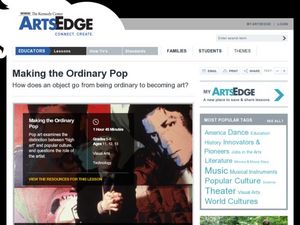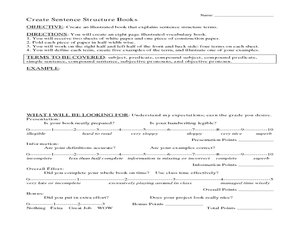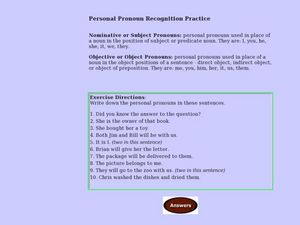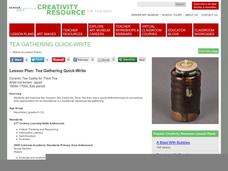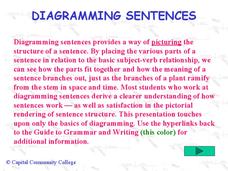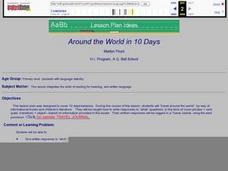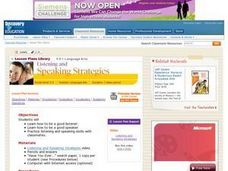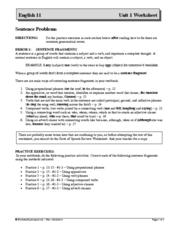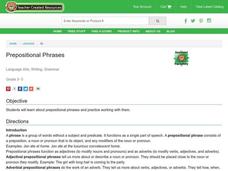Curated OER
Tissue Paper Collage
For this reading and following directions worksheet, students read and follow the steps with pictures for creating a tissue paper collage. Students create 1 collage.
Curated OER
For Public Display
Learners compare three works of art to understand how juxtaposition can express a point of view. They brainstorm topics of interest to them and their respective communities that could act as a springboard for curating individual exhibits...
Curated OER
Making the Ordinary Pop
Students examine the attributes of pop art. In this visual arts lesson, students examine works by Andy Warhol and Claes Oldenburg prior to applying pop art techniques to their own pop art examples.
Curated OER
Create Sentence Structure Books
In this sentence structure worksheet, students create sentence structure books including the concepts of subject, predicate, simple sentences, objective pronouns, and more. Students create 8 books total.
Curated OER
Personal Pronoun Recognition Practice
In this pronouns worksheet, learners learn to recognize nominative or objective pronouns. Students read ten sentences and write every pronoun they see in each.
K12 Reader
Noun Clauses: Acting as a Noun
Noun clauses and how they function in sentences is the focus of this exercise, the final resource in a series of 36 grammar worksheets.
Gwinnett County Public Schools
Analysis of the Tuck Everlasting and The Birchbark House Text Exemplars
Looking to introduce some text-based questions into your ELA lessons? Practice the kinds of skills the Common Core demands with the seven text-based questions and the essay prompt provided here. Designed to be a three-day lesson, day one...
Denver Art Museum
Tea Gathering Quick-Write
Japanese tea gatherings are the inspiration for a great instructional activity. Learners are provided with an image of a tea caddy made for thick tea and asked to describe what they notice and what that might mean. This leads into a...
Curated OER
Grammar Worksheet: Lie vs. Lay
To do something to someone or something or not to do something to someone. That is the question. And it is the source of the confusion between lie and lay. The strength of this worksheet is in the clear, cogent explanation for the...
Curated OER
Active and Passive Voice
How are the active and passive voices different, and when should you use each one? The first page of this two-page worksheet contains the rules and several examples. On the second page, your grammarians will be able to put pen to paper...
Curated OER
Diagramming sentences
In an orderly fashion, go through diagramming sentences with your class. Beginning with a simple sentence and the placement of subject and verb, subsequent slides slowly add on more branches and lines with explanations of sentence types...
Curated OER
I OBJECT! Understanding Transitive Verbs
In this grammar worksheet, learners learn how to use transitive verbs in sentence writing. They then use what they read to answer the 17 questions on the worksheet. The answers are located on the last page of the packet.
Curated OER
Making Instant Whip (Recipe)
In this language arts activity, learners practice sequencing, finding action words and following directions as they make Instant Whip ( a dessert). Students cut picture cards and sequence the steps, then read the recipe and make the...
Curated OER
Personal Pronouns: Putting It All Together
In this personal pronouns activity, students fill in 10 fill in the blank answers about personal pronouns and choose which multiple choice pronoun in parentheses correctly completes 8 sentences. Students practice using the pronouns I or...
K12 Reader
How Things Move
As part of a comprehension exercise, kids read a physical science article about motion and then answer a series of comprehension questions based on the passage.
Soft Schools
Interpreting Metaphors in Shakespeare
"All the world's a stage, and all the men and women merely players." Shakespeare provides the examples on this worksheet that asks readers to identify the two things being compared and to explain the characteristics the two share.
Museum of Tolerance
Cultural Research Activity
Class members explore cultural diversity through a variety of texts that showcase the importance of traditions. Then, they interview their family members to research their own cultural background and write their findings on quilt...
Curated OER
Around the World in 10 Days
Learners engage in producing responses to "what" questions and their written responses will be recorded in a Travel Journal. They produce their respones using a word processor. This lesson is very detailed and a rubic is included.
Curated OER
Listening and Speaking Strategies
Everyone needs help being a good listener! Play a round of "Have You Ever?" with your youngsters, letting them walk around the room and find others who have or haven't done things on your self-created sheet. This game can get really...
Curated OER
The Finer Things in Life
Momoyama and Edo are periods in Japanese history that can be defined culturally and artistically. Learners explore and discuss how the samurai used sword guards and grip enhancers. Pupils read the story "The Inch-High Samurai," examine...
Curated OER
Sentence Problems
Writing is tough to perfect. Help your class improve their writing skills by studying different sentence problems. This reference guide covers sentence fragments, run-ons, and misplaced modifiers, but that's just to start! There's a...
Curated OER
Prepositional Phrases
There are two types of prepositional phrases: adjectival and adverbial. Gather teaching strategies from this resource to give your learners lots of practice and meet Common Core standards! First, review prepositions by providing a...
Shoop English
Literature Terms Activity
Designed to be used with an independent reading book, this activity provides practice with identifying and explaining literary terms. While they read, individuals find instances of literary devices and elements in use in their books....
Curriculum Corner
Inferencing
Inferencing is a necessary reading skill to uncover non-explicit messages in text. Use the set of resources as a way to guide learners toward becoming expert inferrers through reading prompts and literature with text and without text.


